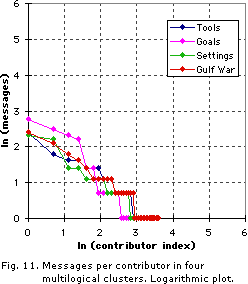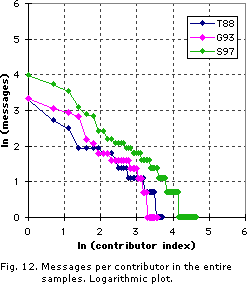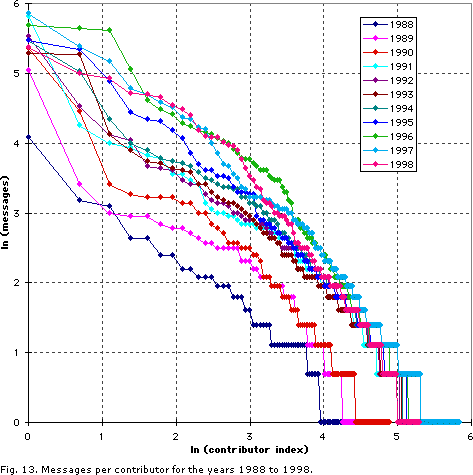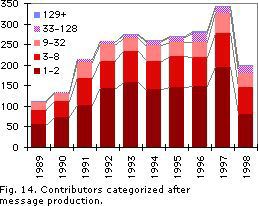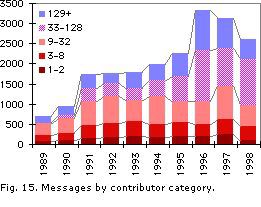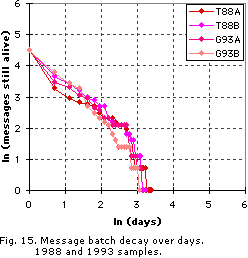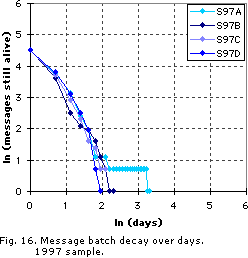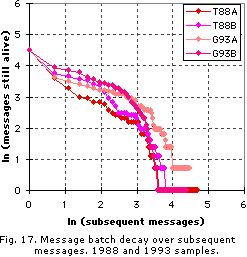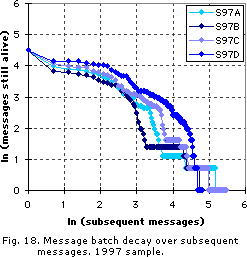Four episodes of joint paper reading: Lotman, Wells, Bateson and
EngeströmI would finally like to return to the problem of harnessing
the multilogical spontaneity of a scholarly mailinglist. The Xlists have
certainly provided a conducive space for the learning of individual
participants, and contributed to the renewal of the community of
practicioners of CHAT approaches. The forum has also served as a channel
for crossfertilization of diverse discourses, brought to the virtual
setting by participants from different disciplinary fields. Arguably the
Xlist discussions have also been enriched by research collaborations
between list participants - here I am thinking particularly of the
international project on Acting in Culture, proposed in 1992. However, a
scholarly mailinglist is more suitable as a setting for learning than as
an setting for actual collaborative research, the list community being too
loosely structured to serve as a channel for collaborative production of a
definite result (Lewenstein, 1995). As far as I know the few attempts at
collective writing over the Xlists have foundered. This is the flip side
of mailinglist self-regulation in the several senses of the term:
socially, technically and as an emergent process.
Concerns for cumulativity and development on the collective level have
prompted core participants to explore ways of harnessing the multilogue by
inserting planned activities into the Xlist setting: exchanges between
local seminar groups, Xlist channeling of communication between similar
courses run at separate locations, setting up of special-purpose
subconferences, joint readings of papers or entire books etc. Here I have
chosen to briefly examine four episodes of joint reading of paper-size
publications, all highly relevant to recurring concerns in the repertory
of Xlist multilogues.
- A reading of Lotman (1988) in the autumn of 1990
- A reading of two pre-publication papers by Wells (Wells, 1993 and
Wells & Chang, 1997) from a methodological perspective in the autumn
of 1992
- A reading of Bateson (1972) in the winter quarter of 1993
- A reading of Engeström (1996) in the autumn of 1996
The
paper selected for a joint reading in the autumn of 1990, Yuri Lotman's,
"Text within Text" (Lotman, 1988) deals with theorizing the relation of
stability and change, closure and open-endedness in language and in
text.The paper is theoretically relevant to many recurring Xlist issues
about intersubjectivity, communication, and relations between text and
context. Lotman argues that text has the dual functions in a cultural
system of on the one hand conveying meanings adequately and on the other
hand creating new meanings. There is an irreducible tension between the
univocal, transmissive function of text and its dialogical function as a
"thinking device". The paper is aptly brought in as a target for joint
reading in the context of a discussion of communication and
miscommunication - a multilogue taking place in the second week of
September 1990. However, the coordination of the event turns out to take
much more time and effort than was anticipated in the initial suggestion.
The journal is not easy to get hold of, and a distribution of photocopies
has to be arranged, so that instead of beginning within a week, it takes
five weeks before a summary of the first part of the article is posted as
a signal for the event to begin. By then the collective enthusiasm has
moved on to other objects - issues about literacy, cross-cultural
research, microgenetic studies, and, eventually, the ethics of videotaping
as a method of collecting data. A few participants contribute to keeping
Lotman in the mailflow, but the exchange is very sparse: there are all in
all 13 Lotmanian discussion postings spread out over 36 days and with
relatively few links between them. On the other hand, the event is one of
the rare episodes that does have a beginning and an end - the paper is
summarized in three sections, and there is a final posting providing
uptake and rounding off after the last summary. There is also evidence in
the archives that the event made a mark in the community: there is at
least one of the longterm Xlist participants who comes back to this paper
more than once, and after months and years - after having been among those
who initially asked for the paper in public because of access problems.
The Lotman episode provides an example of how the spontaneous flow of
multilogue does not sustain the collective patience to hold a topic in
suspension for weeks, for collective action to be taken to provide it with
coordinated grounding in the virtually simultaneous reading of external
material.
The two pre-publication papers by Wells (Wells, 1993 and Wells &
Chang, 1997) chosen for a joint reading in the autumn of 1992 both deal
with the co-construction of meaning through discourse in the classroom,
and the implications of classroom discourse for learning and development.
These are educationally central questions that Xlist multilogues return to
over and over again. However, in the case of this particular event of
joint reading, the papers were not chosen as a target with the purpose of
discussing the educational implications of their results, but for the
purpose of providing a common ground for a suggested discussion of
methodological issues of Activity Theory and data gathering methods like
classroom observation. Issues of methodology and of ideological influence
on research have been around in the Xlist mailstream throughout October
1992, when one contributor posts a request for literature on the topic of
research methodology, and also suggests a number of questions for
discussion on the mailinglist. There are a number of postings giving
bibliographic references over the next few days, and there are also a few
that take up the issue of methodology in response to the questions. Then
it is suggested that it would be a good idea to ground the discussion in
particulars by using some research paper, preferably one with extended
excerpts from classroom discourse so that the process of analysis can be
made visible. The Wells papers are nominated (and agreement obtained from
the authors), and there is an exchange of postings about how the event
should be organized. It is decided that the discussion is to be channeled
into the XCLASS, and the papers to be distributed electronically for the
asking. The initial questioner volunteers to serve as facilitator of the
discussion. Like in the Lotman reading, this episode results in very
little discussion of the intended nature - after the putative start of the
reading event the first week in November there are 11 postings that
recognizably belong to this thread, 7 in the first week and another small
batch of 4 postings after a gap of two weeks, when one contributor asks
when the discussion is supposed to start. In this episode there are three
times as many messages of an administrative character: discussion of the
organization of the event, requests for the papers and for being
subscribed to the XCLASS subconference. Of course there is no knowing how
much of a multilogue on methodology there would have been without the
transformation of the event into a joint reading, but the delay caused by
having a paper distributed and perhaps the very process of organizing the
event over the mailinglist channel, may have diverted the collectively
available time. Limited time for reading the paper carefully enough to
have opinions on its methodology will also have had its effect.
The essay by Bateson, "Form, Substance, and Difference", included in
Steps to an Ecology of Mind (1972), was chosen for a joint reading in the
winter quarter of 1993. Bateson argues for the theorizing of the simplest
unit of mind as an elementary cybernetic system with its messages in
circuit, where the transform of a difference traveling in the circuit is
the elementary unit of ideas. This paper contains two illustrative
examples of such systemic circuits - mind extending outside the boundary
of the skin - that have been recurring objects for Xlist discussion: the
blind man with his stick and the man cutting down a tree with an axe. It
is one of these Batesonian occasions that prompts the suggestion for a
joint reading: Bateson has been invoked several times in the Xlist
mailstream of December 1992, when a joint reading of this particular paper
is suggested. The suggestion is taken up by other participants, but the
matter of organization is quickly channeled outside the public forum,
directly to the contributor who initiated the topic, and who has
volunteered to facilitate the discussion. The second week of January 1993
this participant announces that the Bateson reading will start on February
first, with the first pages of the essay - but it is not until a few days
later that he starts the discussion by forwarding a commentary on the
essay from an external contributor, who soon thereafter joins the list.
After a delay of almost a week, a multilogue does get off the ground: an
initial round of roughly a week, with several participants and quick
responses, followed by a three-week "panel" discussion in slow but steady
pace between three skilled and knowledgeable contributors, posting long
and reflective messages, which often meticulously respond not to the
latest message, but to the last issue left dangling. A file of the
accumulated text from this multilogue has been circulated on the Xlists on
at least one later occasion where Batesonian questions were in the
mailstream. After a month, one week into March, the facilitator opens the
discussion of the final part of the essay, expressing hopes that the
content of this section will appeal to a wider range of contributors. The
next posting praises this invitation, but also turns out to be the final
posting in the episode - the Bateson reading is alluded to as unfinished
business a month afterwards. Nevertheless, in this episode of joint
reading there is not just a larger number of discussion postings than in
the two previous ones (28 in all), but these postings also form an
interconnected multilogical cascade, which cannot be said about the two
events described previously. The successful character of the Bateson
episode is presumably formed by the concise planning of the event, the
ample time given for preparatory reading (or re-reading) of a classical
and easily available essay, and the presence of a "special guest
contributor".
In the fourth case, the Engeström paper, "Development as breaking away
and opening up" (Engeström, 1996), chosen for joint reading in the autumn
of 1996, the initial phases of the joint reading event develop more
rapidly than in any of the other cases: the episode passes from proposal
to discussion in four days. The paper is selected for joint reading just a
little over a week after being presented at the Second Conference for
Sociocultural Research, held in Geneva, September 11-15, 1996. Some of the
Xlist participants who were not going to Geneva had expressed their
interest in post-conference discussion on the list even before the
conference, and the intention was to take up other papers after the first
one had been treated. Engeström's paper argues against theories of
development that look only to the peaceful and stepwise individual
progress along a universal, pre-established developmental path. It
suggests that individual transformation may depend on collective
transformation, that development may be viewed as partially destructive
rejection of the old - rather than simply as benign achievement of mastery
- and that instead of just being a movement across vertical levels,
development may also involve movement across horizontal borders. The
theoretical arguments of the paper are illustrated by means of examples
from Peter Høeg's novel "The Borderliners" (1994), and its re-formulations
of the Vygotskian Zone of Proximal Development are well in line with Xlist
debates over the years. When the paper is first suggested for joint
reading there is briefly some organisational discussion: other papers are
mentioned, the author posts his agreement, and, following a suggestion
that it would be a good idea to make the target paper available over the
MCA Website, there is discussion about the best procedures for putting
papers on the Web. However, on the third day after the initial suggestion
an electronic copy of the paper is sent over the list, and the next day
there are already responses from contributors who have read it. This event
is different from the earlier occasions of joint reading in being a lot
less pre-planned and in having no designated chairperson. In keeping with
its occurrence in the single-list, high-mailflow era of local history
discussion part of it contains a larger number of contributions than any
of the other three joint reading episodes - 53 postings in the course of
three weeks - and there are many crossreferences between strands of the
cluster, although late in the episode an independent thread on the use of
fiction as data develops, which is related to the paper, but not to the
other strands of the multilogue. When the multilogue is far into its phase
of decay there is an announcement that the paper is now available through
the Web page. One of the two last postings in the episode that arrive
after this point is an attempt to bring together some of the issues
brought up and formulate new questions. There is, however, no uptake to
this. The only difference between this episode of joint reading and a
spontaneously emerging multilogue is the fact that the discussion takes
off from the reading of the Engeström paper and keeps returning to this
text. Evidently the strategy of broadcasting the paper on very short
notice worked well as a way of riding the waves of a self-organizing
system. On the other hand, as with other attempts at initiating a new
multilogue by introducing external material, this strategy is a gamble -
although probably less so when the paper is requested by list participants
than when it is first offered up by the author. (There are many instances
of this in the Xlist archives, and, especially in the early years,
paper-length texts sent over the list were likely to be taken as insults
by at least some subscribers, and responded to accordingly. However, with
increasing Internet access, the floating of bulky material into the shared
setting is less commonly seen as an offense.)
The two cases of successfully carried out joint reading shared the
characteristic lack of closure with spontaneously emerging multilogues.
Trying to rekindle a topic that has started to decay may be no more
feasible than leaving the popcorn in the microwave until every single corn
has popped. However, when the pops get few and far between, the late
contributor might win the day by rhetorically tying up loose ends - it
would seem as if the wily writer could produce a fair simulacrum of
consensus with no great risk of being gainsaid. Perhaps the Xlist custom
of leaving always some questions in the air is to be preferred, even to
the price of the frustration that may arise from the lack of closure.
Concluding remarks: tuning in to mailinglist dynamics The
voluntary nature of participation on a scholarly mailinglist, the
distributed character of both the subscriber pool and the technical
facilities coordinating their communicative activity, and not least the
nature of the activity as a semiotic process all merit the description of
mailinglist activity as a self-regulating system. This paper, in dialogue
with its companion
paper, has explored a number of avenues towards conceptualizing and
analyzing the ways in which the scholarly mailinglist can also be regarded
as a self-organizing system of mathematical complexity, pointing, among
other things, to some aspects which exhibit the inverse power law
relationships that indicate a probabilistic system in a state of
self-organizing criticality. The work of generating a viable conceptual
approach has involved a repeated movement back and forth between the
experience of active participation on a scholarly mailinglist, and the
external perspective mediated by representations of the mailinglist
ecology that serve to maintain distance and provide overviews of parts or
aspects of the mailinglist activity system and its products.
Graphical link maps of intermessage references were introduced as a
tool and used for making the temporal structure of multilogical events and
the relations between messages visible. Three fairly large samples chosen
because of containing interesting multilogical episodes were presented,
and graphically represented by link maps, bridging between the perceptions
of subscribers participating in multilogical activity in its expanding and
dissipating phases and an analytical perspective on the events. The
perception of accelerating intensity in the written conversation that
characterizes the emergence of a multilogical cascade corresponds to an
expansion of the system-internal temporality - when the discussion gets
hot the mailinglist takes more reading and writing time from its active
participants each time they visit the virtual setting - and at the same
time there is an increasing density of interlinkage between postings.
However, the expansion contains the seed of its own dissolution, as with
an increasing number of active messages in the system (relevant postings,
old and new) the collective capacity of participants to hold together the
whole semiotic complexity of the multilogue will reach its limit. The
perception of thematic chaining and dissolution into unrelated branches of
conversation correspond to a spatial drifting apart and loss of
connections in the link map. What has been presented here from this
conceptually generative phase of research naturally demands further
testing of its viability.
However, my observations of the several ways in which the activity on a
scholarly mailinglist can be said to be self-regulating warrant some
concluding remarks in the direction of application. For those of us who
wish to capture the learning potential of written conversation in the
mailinglist medium it is important to be well aware of the self-regulating
nature of scholarly mailinglists, in all senses of the word. If nothing
else it may spare us from some disappointments: a self-organizing system
is not really amenable to control or planned change - but it is,
nevertheless, possible to get in tune with the internal dynamics of a
mailinglist, and learn to recognize the moments when small interventions
have a fair chance of triggering noticeable effects. The four case studies
of more or less planned and successful events of joint reading on the
Xlists illustrate both how plans may go wrong in this distributed and
loosely coordinated medium, and how organized episodes may be carried
through, with the right timing in relation to the current dynamics in the
activity system. The success of a scholarly mailinglist as a multilogical
activity system, then, depends on the apt performance of semiotic
self-regulation in the subscriber community, involving for each and every
responsible participant a coordination of the moments of centered
participation with a certain amount of de-centering towards a view of the
emergent states of the mailinglist ecology. On the Xlists these kinds of
facilitation skills have always been regarded as a collective
responsibility for maintenance of the cultural practices of multilogical
discussion. The combination of the centered, participatory appropriation
of these practices with occasional de-centered knowledge-building about
the emergent nature of mailinglist dynamics at a systemic level would seem
to me a promising road towards maintaining practices of mailinglist
re-centering.
 I would like to acknowledge my gratitude
to the whole Xlist community for collegial support, scholarship and
friendship during my years as a virtual neighbor (starting in November
1993). Mike Cole and Arne Raeithel provided me with the encouragement and
inspiration to take up mailinglist dynamics as an object of research. My
quotations of their messages are an expression of my indebtedness: they
"said it all" before I even got there. Any mistakes I have made while
filling in the blanks between their wizardly intuitions and the
cyber-archaeological material are, of course, my own. I would like to acknowledge my gratitude
to the whole Xlist community for collegial support, scholarship and
friendship during my years as a virtual neighbor (starting in November
1993). Mike Cole and Arne Raeithel provided me with the encouragement and
inspiration to take up mailinglist dynamics as an object of research. My
quotations of their messages are an expression of my indebtedness: they
"said it all" before I even got there. Any mistakes I have made while
filling in the blanks between their wizardly intuitions and the
cyber-archaeological material are, of course, my own.
This work was supported by The Swedish Council for Research in the
Humanities and Social Sciences (HSFR).
Opinions are those of the author
and are not necessarily those of the Council.
ReferencesBak, Per. 1996. How Nature Works,
NY:Springer-Verlag.
Barbatsis, Gretchen, Michael Fegan and Kenneth Hansen. 1999. The
Performance of Cyberspace: an Exploration inti Computer Mediated Reality.
Journal of Computer Mediated Communication [On-line], 5 (1).
Available at URL = http://www.ascusc.org/jcmc/vol5/issue1/barbatsis.html
Barowy, William. 1999. A Model for Temporal Self-Regulation in
Electronic Learning Communities. Paper presented in the symposium: Time
and coordination in a virtual community of learners. EARLI (European
Association for Research on Learning and Instruction), Göteborg, Sweden,
August 24-28 1999.
Bateson, Gregory. 1972. Form, Substance, and Difference. In Steps to
an Ecology of Mind. pp. 448-466. New York: Ballantine Books.
Baym, Nancy. 1996. "Agreements and Disagreements in a Computer-Mediated
Discussion", Research on Language and Social Interaction 29(4):
315-345.
Black, Steven. D. James A. Levin, Hugh Mehan and Clark N. Quinn (1983).
Real and non-real time interaction: Unraveling the multiple threads of
discourse. Discourse Processes, 6, 59-75.
Cole, Michael. 1997. From The Creation of Settings to the Sustaining of
Institutions. Mind, Culture, and Activity. 4(3): 183-190
Cole, Michael, and Yrjö Engeström. 1993. A cultural-historical approach
to distributed cognition. In G. Salomon (ed) Distributed Cognitions.
Psychological and educational considerations. Cambridge MA: Cambridge
University press.
Decker, William M. 1998. Epistolary Practices. Letter Writing in
America before Telecommunications. Chapel Hill: University of North
Carolina Press
Donath, Judith, Karrie Karahalios, and Fernanda Viégas. 1999.
Visualizing Conversation. Journal of Computer Mediated
Communication [On-line], 4 (4). Available at URL = http://www.ascusc.org/jcmc/vol4/issue4/donath.html
Dooley, Kevin J., and Andrew H. Van de Ven. 1997. A Primer on
Diagnosing Dynamic Organizational Processes. Available at URL: http://www.eas.asu.edu/~kdooley/os.pdf
Ekeblad, Eva. 1998. Contact, Community and Multilogue: Electronic
communication in the practice of scholarship. Paper presented at The
Fourth Congress of the International Society for Cultural Research and
Activity Theory, ISCRAT 1998, Aarhus University, Denmark, June 7-11, 1998.
Available at URL: http://cite.ped.gu.se/Eklanda/Papers/ISCRAT/CoCoMu.html
Engeström, Yrjö. 1996. Development as breaking away and opening up: a
challenge to Vygotsky and Piaget. Paper presented at at the IInd
Conference for Sociocultural Research, Geneva, 11-15 September 1996.
Galegher, Jolene, Lee Sproull, and Sara Kiesler. 1998. Legitimacy,
authority, and community in electronic support groups. Written
Communication 15(4), 493-530.
Gruber, Helmut. 1998. Computer-mediated communication and scholarly
discourse: forms of topic-initiation and thematic development.
Pragmatics: 8(1): 21-45
Herring, Susan. 1999. Interactional coherence in CMC. Journal of
Computer Mediated Communication [On-line], 4 (4). Available at URL =
http://www.ascusc.org/jcmc/vol4/issue4/herring.html
Herrmann, Françoise. 1998. Building on-line communities of practice: an
example and implications. Educational Technology, 38 (1), 16-23.
Høeg, Peter. 1994. Borderliners. New York: Farrar, Straus and
Giroux.
Jones, Quentin. 1997. Virtual-Communities, Virtual Settlements &
Cyber-Archaeology: A Theoretical Outline. Journal of Computer Mediated
Communication [On-line], 3 (3). Available at URL = http://www.ascusc.org/jcmc/vol3/issue3/jones.html
Leont'ev, A. N. 1978. Activity, Consciousness and Personality.
Englewood Cliffs, NJ: Prentice-Hall.
Leont'ev, A. N. 1982. Problems of the Development of the Mind.
Moscow: Progress Publishers.
Lewenstein, Bruce. 1995. Do Public Electronic Bulletin Boards Help
Create Scientific Knowledge? The Cold Fusion Case. Science, Technology,
& Human Values 20(2): 123-149
Levin, James A., Haesun Kim, and Margaret M. Riel. 1990. Analyzing
instructional interactions on electronic message networks. In: L.M.
Harasim (Ed) Online Education. New York: Praeger.
Lotman, Yuri M. 1988. Text within Text. Soviet Psychology, 1988,
Vol. 26, No. 3 pp 32-51
McElhearn, Kirk. 1996. Writing Conversation: An Analysis of Speech
Events in E-mail Mailing Lists. Available at URL: http://www.mcelhearn.com/cmc.html
Moll, Luis. 1997. The Creation of Mediating Settings. Mind, Culture,
and Activity. 4(3): 191-199
Mulkay, Michael J. 1985. The word and the world: explorations in the
form of sociological thought. Winchester: Allen & Unwin.
Palme, Jacob. 1989. Elektronisk post. Lund: Studentlitteratur.
Palme, Jacob. 1995. The Optimal Group Size in Computer Mediated
Communication. In J. Palme. Electronic Mail. London UK: Artech
House Publishers. The relevant excerpt is available at URL: http://www.dsv.su.se/~jpalme/e-mail-book/group-size.html
Raeithel, Arne. 1992. Semiotic self-regulation and work. An
activity-theoretical foundation for design. In C.Floyd, H. Züllighoven, R.
Budde & R. Keil-Slawik (Eds.), Software development and reality
construction (pp 391-415). Berlin: Springer
Raeithel, Arne. 1996. On the ethnography of cooperative work. In: Y.
Engeström and D. Middleton (Eds.) Communication and Cognition at
Work. New York: Cambridge University Press
Rafaeli, Sheizaf and Fay Sudweeks. 1996. Networked Interactivity.
Journal of Computer Mediated Communication [On-line], 2 (4).
Available at URL = http://www.ascusc.org/jcmc/vol2/issue4/rafaeli.sudweeks.html
Rojo, Alejandra. 1995. Participation in scholarly electronic forums. A
University of Toronto Ph.D. thesis. Electronically available at URL: http://www.oise.on.ca/~arojo/tabcont.html
Sandbothe, Mike. 1998. Media Temporalities in the Internet: Philosophy
of Time and Media with Derrida and RortyJournal of Computer Mediated
Communication [On-line], 4 (2). Available at URL = http://www.ascusc.org/jcmc/vol4/issue2/sandbothe.html
Sarason, Seymour, 1997. Revisiting The Creation of Settings. Mind,
Culture, and Activity 4(3): 170-182.
Shank, Gary. 1993. Abductive multiloguing. The semiotic dynamics of
navigating the Net. Arachnet Electronic Journal on Virtual Culture v1n01
(March 22, 1993) URL = ftp://ftp.lib.ncsu.edu/pub/stacks/aejvc/aejvc-v1n01-shank-abductive
Star, Susan Leigh, and James R. Griesemer. 1989. Institutional ecology,
'translations' and boundary objects: amateurs and professionals in
Berkley's museum of vertebrate zoology, 1907-1939. Social Studies of
Science, 19: 387-420.
Syverson, Margaret A. 1994. The wealth of reality: an ecology of
composition. Ph.D Dissertation, UCSD.
Syverson, Margaret A. 1999. The wealth of reality: an ecology of
composition. Southern Illinois Univ Press
Wells, Gordon and Gen-Ling Chang. 1997. "What have you learned?":
Co-constructing the meaning of time. In J. Flood, S. Brice-Heath and D.
Lapp (Eds.) A Handbook for Literacy Educators: Research on Teaching the
Communicative and Visual Arts. New York: Macmillan.
Wells, Gordon. 1993. Reevaluating the IRF sequence: A proposal for the
articulation of theories of activity and discourse for the analysis of
teaching and learning in the classroom. Linguistics and Education
5: 1-37
Vygotsky, Lev.S. 1934/1987. Thinking and speech. In R.W. Rieber and
A.S. Carton (Eds.) The collected works of L.S. Vygotsky, Volume 1:
Problems of general psychology. (Trans. N. Minick). New York: Plenum.
|
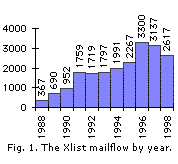
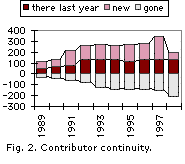
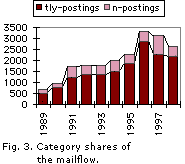


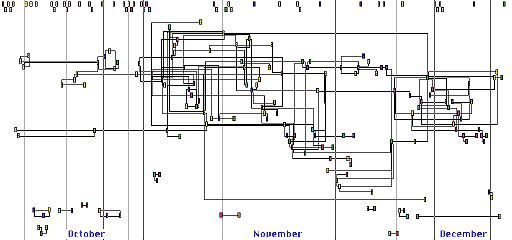

 The link maps make visible both differences and
similarities between the three samples. On the side of difference, the
increasing mailflow over the years is evident. An increasing number of
messages are crammed into the same horisontal space, which also represents
a decreasing span of calendar time. There is a corresponding increase in
the density of interactions: the increasing number of links active in
parallel corresponds to an increase in the pool of messages still in
active relationship with writers in the ecology of composition at any
given time. The increasing mailflow is accompanied by an increasing drift
from topic to topic. The Tools Multilogue and the Goals Multilogue both
stand out as the absolutely major event in the channel (or subchannel) for
weeks and months, while the Settings Multilogue competes with several
other topics (see
The link maps make visible both differences and
similarities between the three samples. On the side of difference, the
increasing mailflow over the years is evident. An increasing number of
messages are crammed into the same horisontal space, which also represents
a decreasing span of calendar time. There is a corresponding increase in
the density of interactions: the increasing number of links active in
parallel corresponds to an increase in the pool of messages still in
active relationship with writers in the ecology of composition at any
given time. The increasing mailflow is accompanied by an increasing drift
from topic to topic. The Tools Multilogue and the Goals Multilogue both
stand out as the absolutely major event in the channel (or subchannel) for
weeks and months, while the Settings Multilogue competes with several
other topics (see  In the spatial representation of the link maps a
message cascade necessarily spreads vertically as the number of active
messages in it increases. This serves well as a metaphor for how the
conceptual chains drift apart. As the multilogue unfolds in time it is
simply not possible for each contributor to explicitly take account of all
previous postings in the episode, much less to preserve topical coherence
with them.
In the spatial representation of the link maps a
message cascade necessarily spreads vertically as the number of active
messages in it increases. This serves well as a metaphor for how the
conceptual chains drift apart. As the multilogue unfolds in time it is
simply not possible for each contributor to explicitly take account of all
previous postings in the episode, much less to preserve topical coherence
with them.
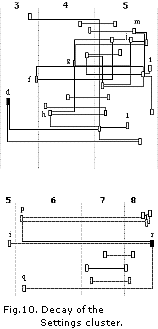 The reduction illustrates quite nicely how common
origin may be forgotten as a multilogical episode starts to decay. The
spatial drifting apart of branches corresponds, at least metaphorically,
with the way different strands of a multilogue take up different aspects
of the topic and bring them in very different directions, in the fashion
of Vygotsky's chains and complexes. So the link map shows how the network
of intermessage references gets looser in the decay phase of a cascade.
The frequency of posting goes down, and unless other clusters have started
growing the list-internal timeflow shrinks. While there have certainly
been expiring branches throughout the development of a multilogical
cascade, soon there is no other kind. This is, of course, just a
description in words of what the link map makes visible as the nature of
endings: in the final phase few postings evoke further response, and these
final postings often have little connection with each other. However,
there are also postings even late in the life of an episode that cross
over and tie together nodes widely apart in the net of past messages -
whether by seriously attempted integration, witty application of a phrase
transported from one context to the other, or just a friendly nudge to
neighbours discussing another topic: there are many possibilities. The
exemplar in day 8 of the Settings Multilogue happens to be of the kind
where a latecomer seriously attempts an integration and reformulation of
questions without receiving any further response. This happens with a
certain regularity - individual actions are not enough to turn the tide of
a decaying topic. Visually, in terms of the link map, these postings close
the local structure, but as the genre of summary adopted on the Xlists
seems oriented towards bringing the discussion further, they usually
contribute questions and challenges, which, when left without uptake,
contributes to the unfinished and frustrating quality of multilogical
endings. This may be a point where participants might adapt their
practices to the contingencies of the medium, and learn to produce
"closing turns" to threads that are "running out" - an idea with some
connection to practices of joint reading and other applied forms of
structured events on scholarly mailinglists.
The reduction illustrates quite nicely how common
origin may be forgotten as a multilogical episode starts to decay. The
spatial drifting apart of branches corresponds, at least metaphorically,
with the way different strands of a multilogue take up different aspects
of the topic and bring them in very different directions, in the fashion
of Vygotsky's chains and complexes. So the link map shows how the network
of intermessage references gets looser in the decay phase of a cascade.
The frequency of posting goes down, and unless other clusters have started
growing the list-internal timeflow shrinks. While there have certainly
been expiring branches throughout the development of a multilogical
cascade, soon there is no other kind. This is, of course, just a
description in words of what the link map makes visible as the nature of
endings: in the final phase few postings evoke further response, and these
final postings often have little connection with each other. However,
there are also postings even late in the life of an episode that cross
over and tie together nodes widely apart in the net of past messages -
whether by seriously attempted integration, witty application of a phrase
transported from one context to the other, or just a friendly nudge to
neighbours discussing another topic: there are many possibilities. The
exemplar in day 8 of the Settings Multilogue happens to be of the kind
where a latecomer seriously attempts an integration and reformulation of
questions without receiving any further response. This happens with a
certain regularity - individual actions are not enough to turn the tide of
a decaying topic. Visually, in terms of the link map, these postings close
the local structure, but as the genre of summary adopted on the Xlists
seems oriented towards bringing the discussion further, they usually
contribute questions and challenges, which, when left without uptake,
contributes to the unfinished and frustrating quality of multilogical
endings. This may be a point where participants might adapt their
practices to the contingencies of the medium, and learn to produce
"closing turns" to threads that are "running out" - an idea with some
connection to practices of joint reading and other applied forms of
structured events on scholarly mailinglists.
